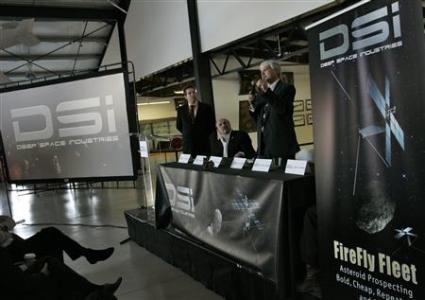
CAPE CANAVERAL, Fla., Jan 22 - A team of entrepreneurs and engineers unveiled plans on Tuesday for a space mining company that would tap nearby asteroids for raw materials to fuel satellites an d manufacture components in orbit.
d manufacture components in orbit.
Deep Space Industries, based in Santa Monica, California, said its inaugural mission is targeted for 2015, when it would send a small hitchhiker spacecraft called "Firefly" on a six-month expedition to survey an as-yet-unidentified asteroid.
The 55-pound (25-kg) satellite, about the size of a laptop computer, would be launched as a secondary payload aboard a commercial rocket carrying a communications satellite or other robotic probe.
About 1,000 small asteroids relatively close to Earth are discovered every year. Most, if not all, are believed to contain water and gases, such as methane, which can be turned into fuel, as well as metals, such as nickel, which can be used in three-dimensional printers to manufacture components, David Gump, chief executive of Deep Space Industries, said.
Gump is a co-founder of three previous space and technology start-ups, including Astrobotic Technology, which is focused on exploration and development of lunar resources.
"There is really nothing in the business plan that Deep Space Industries is pursuing that cannot be done with technology research already accomplished in laboratories across the planet," said John Mankins, a former NASA Jet Propulsion Laboratory manager who is the start-up company's chief technical officer.
"The technology may not have been used in space for the exact purposes that we propose, but the fundamental technologies are really at hand," Mankins said.
Company officials, who unveiled their plans at a press conference at the Museum of Flying in Santa Monica, California, that was also webcast, did not comment on their financial backing except to say they were looking for investors.
Deep Space Industries is the second company to unveil plans to mine asteroids, rocky bodies of various sizes that orbit the sun. So far about 9,500 asteroids have been found in orbits that come near Earth. Small fragments of asteroids regularly pass through the planet's atmosphere, lighting up the night sky as they incinerate and occasionally surviving to become meteorites.
Last year, Planetary Resources, a Bellevue, Washington-based company backed by high-profile investors including Google executives Larry Page and Eric Schmidt and advisers like filmmaker James Cameron, announced a program that would begin with small, low-cost telescopes to scout for potentially lucrative asteroids.
Firefly, as well as a follow-on line of planned asteroid sample-return satellites called Dragonfly, would be based on miniature research spacecraft known as CubeSats that are built from commercially available, off-the-shelf electronic components.
The cost of a Firefly mission would be about $20 million, half of which the company expects will come from government and research institute contracts and half from corporate advertising, sponsorships and other marketing ventures, said Gump.
The follow-on Dragonfly missions, scheduled to begin in 2016, would entail returning 50 to 100 pounds (23 to 45 kg) of material from select, high-value asteroids, an endeavor that would take two to three years.
In addition to selling samples, Deep Space Industries wants to grind up some of the material, extract metals and other valuable commodities and develop the technology to produce fuel and components, such as solar cells, in space.
The company said it has a patent pending on a three-dimensional printer called a "Microgravity Foundry" that uses lasers to deposit nickel in precise patterns in zero gravity.
On Earth, similar printers produce three-dimensional components by depositing layers of nickel metal powder. The process is somewhat like the buildup of ink on paper in a traditional ink jet printer.
Gump said the patent was filed within the past 18 months and is not yet listed in publicly accessible databases.
The ultimate goal is to build a fleet of robotic ships to extract resources for fuel and to mine valuable minerals from asteroids.
"We're at an early stage," said Gump. "It'll probably be 2019 or 2020 before we'll have commercial quantities of propellant for sale."

 Previous page
Previous page Back to top
Back to top







